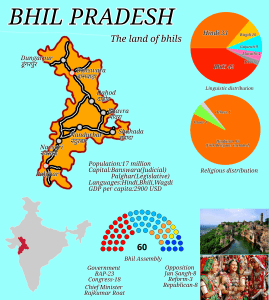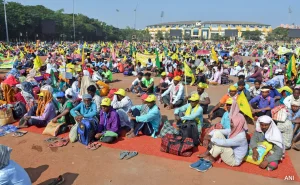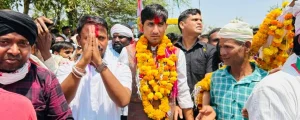The demand for a separate Bhil Pradesh state has gained renewed vigour as tribal communities from four states converged at the historic Mangarh Dham. This significant gathering marks a pivotal moment in the decades-long struggle for tribal self-determination and autonomous governance. The movement, which spans across 43 districts in Rajasthan, Madhya Pradesh, Gujarat, and Maharashtra, represents one of India’s most enduring indigenous rights campaigns.
The Bhil Pradesh state movement is not merely about administrative reorganisation; it embodies the aspirations of millions of tribal people who seek recognition, representation, and the right to govern their ancestral lands according to their traditional systems. The gathering at Mangarh Dham, a site of immense historical and cultural significance for the Bhil community, symbolises the unity and determination of these indigenous groups.
The Bhil community, one of India’s largest tribal groups, has inhabited the regions now demanding statehood for centuries. Their rich cultural heritage, traditional governance systems, and deep connection to the land form the foundation of the Bhil Pradesh state demand. These communities have long felt marginalised within the existing state structures, leading to persistent calls for a separate administrative entity that would better serve their unique needs and aspirations.
 The proposed Bhil Pradesh state would encompass territories where Bhil and other tribal communities form significant populations. This includes districts from Rajasthan’s southern regions, eastern Gujarat’s tribal belt, western Madhya Pradesh’s indigenous areas, and northern Maharashtra’s tribal-dominated zones. The geographical spread of this movement demonstrates the extensive tribal presence across state boundaries and their shared vision for autonomous governance.
The proposed Bhil Pradesh state would encompass territories where Bhil and other tribal communities form significant populations. This includes districts from Rajasthan’s southern regions, eastern Gujarat’s tribal belt, western Madhya Pradesh’s indigenous areas, and northern Maharashtra’s tribal-dominated zones. The geographical spread of this movement demonstrates the extensive tribal presence across state boundaries and their shared vision for autonomous governance.
The Bhil Pradesh state demand encompasses an impressive 43 districts across four existing states, highlighting the movement’s substantial geographic and demographic scope. This vast area includes some of India’s most culturally rich and ecologically diverse regions, where tribal communities have maintained their traditional lifestyles and governance practices for generations.
Also Read: Bhil Pradesh state
In Rajasthan, the movement includes districts like Banswara, Dungarpur, and Udaipur, where tribal populations constitute significant majorities. Gujarat’s contribution includes Dahod, Panchmahal, and parts of Sabarkantha, regions known for their tribal heritage and cultural distinctiveness. Madhya Pradesh’s involvement encompasses districts such as Jhabua, Alirajpur, and Barwani, while Maharashtra’s participation includes Nandurbar and adjoining tribal areas.
The proposed Bhil Pradesh state would create a unique administrative model that recognises tribal autonomy while maintaining constitutional frameworks. This approach could serve as a precedent for other indigenous movements across India, demonstrating how traditional governance systems can coexist with modern administrative structures.


The Bhil Pradesh state vision includes strengthening traditional panchayati systems, promoting indigenous languages and cultures, and implementing development models that respect ecological sustainability. Community leaders emphasise that self-governance would enable them to address issues like land rights, forest access, education in native languages, and healthcare services tailored to tribal needs.
Furthermore, the movement advocates for constitutional protections that would safeguard tribal lands from exploitation while promoting sustainable economic development. The proposed Bhil Pradesh state would prioritise community-based resource management, ensuring that natural resources benefit local populations rather than external corporate interests.
The Bhil Pradesh state movement operates within complex political dynamics involving multiple state governments, central authorities, and diverse tribal organisations. Each of the four states has different perspectives on the statehood demand, influenced by their political considerations, resource implications, and administrative challenges.
Supporters argue that the Bhil Pradesh state would enable more focused development initiatives, better representation in legislative bodies, and improved service delivery to tribal populations. They point to successful examples of smaller states that have achieved better governance outcomes and argue that tribal-majority states could similarly benefit from autonomous administration.
Critics, however, raise concerns about the economic viability of the proposed Bhil Pradesh state, potential administrative challenges, and the precedent it might set for other regional movements. They argue that existing constitutional provisions, including the Fifth Schedule areas, already provide adequate protection and development opportunities for tribal communities.


The Bhil Pradesh state movement is deeply intertwined with efforts to preserve and promote tribal cultures, languages, and traditional knowledge systems. Leaders emphasise that statehood would provide institutional support for cultural preservation while enabling communities to modernise on their terms.
The gathering at Mangarh Dham reinforced the cultural dimensions of the Bhil Pradesh state demand, as participants performed traditional ceremonies, shared cultural expressions, and reaffirmed their commitment to preserving their ancestral heritage. This cultural revival aspect of the movement resonates strongly with younger tribal generations who seek to balance modernity with traditional values.
As the Bhil Pradesh state movement gains momentum, it faces both opportunities and challenges. The renewed gathering at Mangarh Dham demonstrates sustained popular support and organisational capacity. However, the movement must navigate complex political negotiations, address economic concerns, and build broader consensus across different stakeholder groups.
The success of the Bhil Pradesh state demand will likely depend on the movement’s ability to present viable governance models, demonstrate economic sustainability, and maintain unity across diverse tribal communities. The movement’s emphasis on self-governance and community rights aligns with broader global trends toward indigenous self-determination, potentially garnering wider support.
The tribal communities’ renewed commitment to the Bhil Pradesh state vision, as demonstrated at Mangarh Dham, signals their determination to pursue this decades-long aspiration through democratic means while preserving their cultural identity and traditional governance systems.

